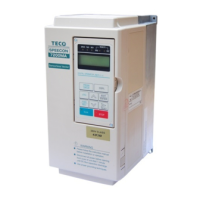86
•Frequency UP/DOWN Function (Setting:28)
•The inverter can use either the digital operator or external multi-function input
terminals (terminal i or j) to change the output frequency upward or
downward.
•By setting the parameters of (Sn-04= 1,Sn-05= 1), firstly the run source and
frequency command is set through the control circuit terminals. Secondly, set
the parameter Sn-28 = 28 (terminal i will now have the function “UP”, its
original function is disabled). Then, terminal i and j can be used for “UP”
and “DOWN” function to control /change the output frequency.
•Operation sequence as below:
Control circuit terminal
i
: UP function ON OFF OFF ON
Control circuit terminal
j
: DOWN function OFF ON OFF ON
Operation status
ACC
(UP)
DEC
(DOWN)
Constant
(HOLD)
Constant
(HOLD)
FWD
REV
UP
output freq.
DOWN
upper limit
lower limit
terminal or
terminal
terminal
D1 H DUHHHHD1HDUD1HD U
U = UP (ACC) status U1 = bounded from upper_limit while ACC
D = DOWN (DEC) status D1 = bounded from lower_limit while DEC
H = HOLD (Constant) status
U1
1 2
7
8
Fig. 45 Time chart of output frequency with the UP/DOWN function
•Only set through parameter Sn-28
•When the frequency UP/DOWN function is being used, the output frequency
will accelerate to the lower_limit (Cn-19) if a run command is pressed.
•The output frequency held by the UP/DOWN function will be stored in memory.
This output frequency will be retained even after a power loss. When power is
back, the inverter will restart at this hold frequency if a run command is pressed
next time.
•When the UP/DOWN function and jog frequency command are both assigned to
multi-function inputs, the jog frequency command input has the highest priority.
•Forced Run (Setting:29)
•Only set through parameter Sn-28. It is for special use (smoke fan, etc.)

